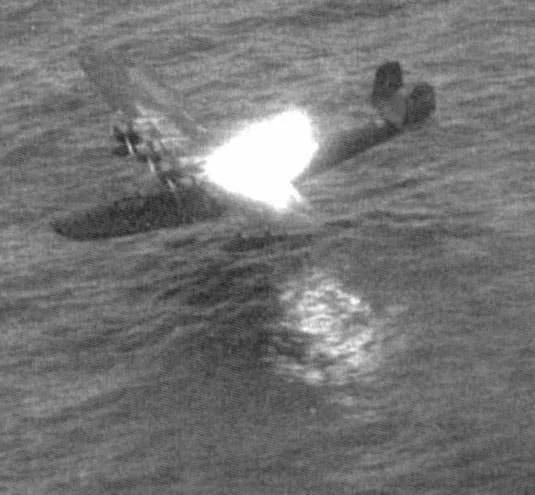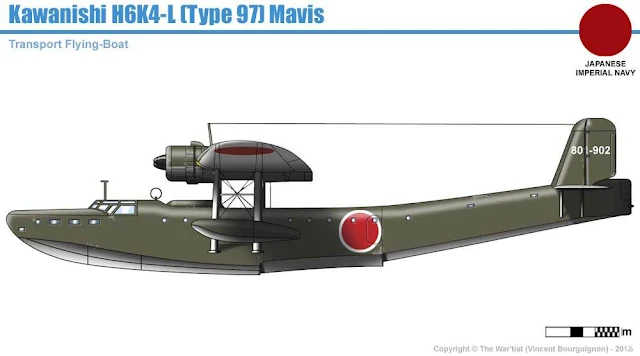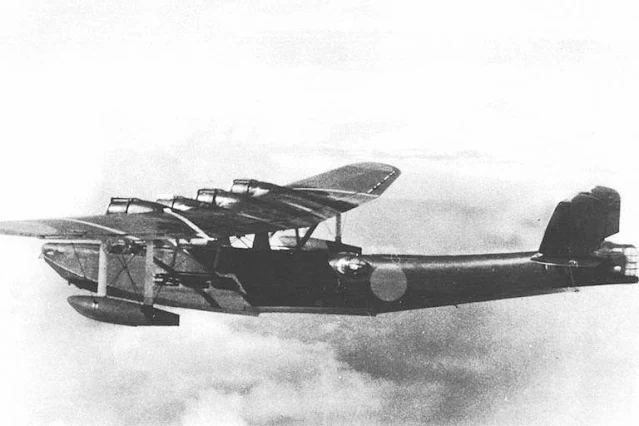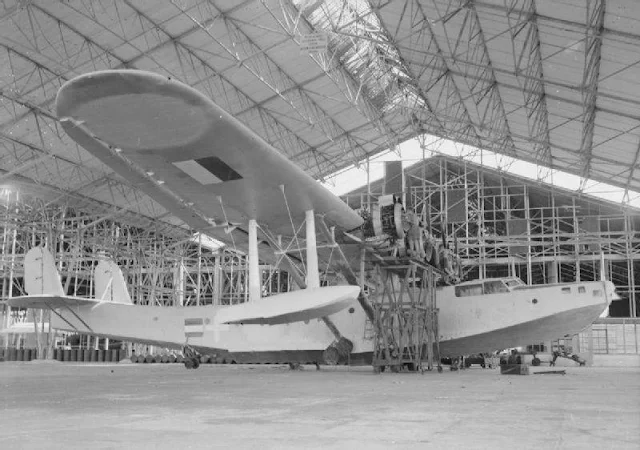The Kawanishi H6K was an Imperial Japanese Navy flying boat produced by the Kawanishi Aircraft Company and used during World War II for maritime patrol duties. The Allied reporting name for the type was Mavis; the Navy designation was "Type 97 Large Flying Boat". Developed in the 1930s, it was used for reconnaissance, transport, bombing, naval warfare, and executive transport by the Imperial Japanese Navy. The national airline also used it as a commercial airliner. The British mistakenly identified this aircraft as the Kawanishi Navy 97 Mavis.
Design and Development
The aircraft was designed in response to a Navy requirement of 1934 for a long-range flying boat and incorporated knowledge gleaned by a Kawanishi team that visited the Short Brothers factory in the UK, at that time one of the world's leading producers of flying boats, and from building the Kawanishi H3K, a license-built, enlarged version of the Short Rangoon. The "Type S", as Kawanishi called it, was a large, four-engined monoplane with twin tails, and a hull suspended beneath the parasol wing by a network of struts. Three prototypes were constructed, each one making gradual refinements to the machine's handling both in the water and in the air, and finally fitting more powerful engines. The first of these flew on 14 July 1936 and was originally designated "Navy Type 97 Flying Boat", later H6K. Eventually, 217 were built.
Production and Engines
Four prototypes were produced leading to the production version, with ten H6K2 built, then 124 H6K4 were produced which had better fuel capacity. All H6K were powered by four radial piston engines of different types. Some aircraft were upgraded with the 1000 hp Kinsei 46, and the H6K5 had the 1300 hp Kinsei 51/53.
The H6K prototype was powered by four 9-cylinder Nakajima Hikari 2 with 840 hp.
Additional production:
Sixteen H6K2-L unarmed transports
Two (2) H6K4-L VIP transports
Twenty (20) H6K4-L unarmed transports with the Kinsei 46 engines
Thirty-six H6K5s with Kinsei 51/53
Sixteen (16) aircraft were civilian air transports operated by Dai-Nippon Airways (the Imperial Japanese National airline), with on board toilet, galley, and room for 18 passengers. They had civil registration and were used for mail and passenger service to the Pacific.
Combat H6K were armed with various combinations of Type 92 machine guns, and it could also carry two torpedoes or 1000kg of bombs.
Operational History
H6Ks were deployed from 1938 onwards, first seeing service in the Sino-Japanese War and were in widespread use when the Pacific War began in December 1941. At the start of the war, four Kōkūtai (naval air groups) operated a total of 66 H6K4s. Also, sixteen were used by the Imperial Japanese airline for mail and passenger service to the Pacific.
On 12 December 1941, during the Battle of Wake Island, an H6K bombed Wake island, but it was shot down by an F4F Wildcat.
On 15 February 1942, a P-40 Warhawk intercepted an H6K, about 190 km west of Darwin, Australia, which had attacked Allied shipping; both the P-40 and H6K were shot down.
The type had some success over Southeast Asia and the Southwest Pacific. H6Ks had excellent endurance, flying up to 24-hour patrols, and were often used for long-range reconnaissance and bombing missions. From bases in the Dutch East Indies, they could fly over a large portion of Australia.
However, the H6K became vulnerable to a newer generation of more heavily armed and faster fighter aircraft. In front-line service, it was replaced by the Kawanishi H8K. It continued in service throughout the war but in areas where the risk of interception was low.
Variants
H6K1: Evaluation prototypes with four Nakajima Hikari 2 engines, four built.
H6K1 (navy flying boat Type 97 Model 1): Prototypes with 746 kW (1,000 hp) Mitsubishi Kinsei 43 engines, three converted from the original H6K1 prototypes
H6K2 Model 11: First production model. Includes two H6K2-L officer transport modification, 10 built.
H6K2-L (navy transport flying boat Type 97): Unarmed transport version of H6K2 powered by Mitsubishi Kinsei 43 engines, 16 built
H6K3 Model 21: Modified transport version of H6K2 for VIPs and high-ranking officers, 2 built
H6K4 Model 22: Major production version, modified H6K2 with revised weapons, some with 694 kW (930 hp) Mitsubishi Kinsei 46 engines. Fuel capacity increased from 7,764 L (1,708 Imp gal) to 13,410 L (2,950 Imp gal). Includes two H6K4-L transport versions, 100 to 127 (if other numbers are all correct) built.
H6K4-L: Transport version of H6K4, similar to H6K2-L, but with Mitsubishi Kinsei 46 engines, 20 built and another two converted from the H6K4
H6K5 Model 23: Fitted with 969 kW (1,300 hp) Mitsubishi Kinsei 51 or 53 engines and new upper turret replacing the open position, 36 built
Operators
Japan
Imperial Japanese Navy Air Service
Imperial Japanese Airways
Used on the routes Yokohama-Saipan-Koror (Palau)-Timor, Saigon-Bangkok and Saipan-Truk-Ponape-Jaluit
Indonesia
Air Service Volunteer Corps - A single H6K5 flying boat was restored to flight by British and Indonesian forces during the Indonesian War of Independence.
Specifications (H6K4 Model 22)
Type: Maritime patrol flying boat
National origin: Japan
Manufacturer: Kawanishi
Status: Retired
Primary user: Imperial Japanese Navy Air Service
Number built: 215
Introduction date: January 1938
First flight: 14 July 1936
Retired: 1945
Developed from: Kawanishi H3K
Crew: 9
Length: 25.63 m (84 ft 1 in)
Wingspan: 40 m (131 ft 3 in)
Height: 6.27 m (20 ft 7 in)
Wing area: 170 m2 (1,800 sq ft)
Empty weight: 11,707 kg (25,810 lb)
Gross weight: 17,000 kg (37,479 lb)
Maximum takeoff weight: 21,500 kg (47,399 lb)
Powerplant:
4 × Mitsubishi Kinsei 43 14-cylinder air-cooled radial piston engines, 750 kW (1,000 hp) each for take-off
738 kW (990 hp) at 2,800 m (9,200 ft)
(H6K4 Model 2-3 and H6K4-L 690 kW (930 hp) Kinsei 46)
Maximum speed: 340 km/h (210 mph, 180 kn) at 4,000 m (13,000 ft)
Cruise speed: 222 km/h (138 mph, 120 kn) at 4,000 m (13,000 ft)
Range: 4,797 km (2,981 mi, 2,590 nmi)
Ferry range: 6,080 km (3,780 mi, 3,280 nmi)
Wing loading: 100 kg/m2 (20 lb/sq ft)
Power/mass: 0.1731 kW/kg (0.1053 hp/lb)
Guns:
1× 7.7 mm (0.30 in) Type 92 machine gun in nose
1× Type 92 machine gun in spine
2× Type 92 machine guns in waist blisters
1× 20 mm (0.79 in) Type 99 Mark 1 machine gun in tail turret
Bombs:
2× 800 kg (1,764 lb) torpedoes
or
1,000 kg (2,205 lb) of bombs
Bibliography
Doubilet, David. "The Flying Boat". Sport Diver Magazine. Volume 15, Number 8, September 2007.
Francillon, René J. (1979). Japanese aircraft of the Pacific War. London: Putnam. ISBN 0-370-30251-6. (New edition 1987 by Putnam Aeronautical Books.)
Green, William (1962). Warplanes of the Second World War: Volume Five, Flying Boats. Macdonald.
Lawrence, Joseph (1945). The Observer's Book Of Airplanes. London and New York: Frederick Warne & Co.
"Kawanishi's Parasol Patroller". Air International. Vol. 29, no. 6. December 1985. pp. 293–298, 304–305.
"Pentagon Over The Islands...The Thirty Year History of Indonesian Military Aviation". Air Enthusiast Quarterly. No. 2, n.d. pp. 154–162.
Richards, M.C. "Kawanishi 4-Motor Flying-Boats (H6K 'Mavis' and H8K 'Emily')". Aircraft in Profile Volume 11. Windsor, Berkshire, UK: Profile Publications Ltd., 1972.
Van der Klaauw, Bart. Water- en Transportvliegtuigen Wereldoorlog II (in Dutch). Alkmaar, the Netherlands: Uitgeverij de Alk.
 |
| Kawanishi H6K civilian version. |
 |
| This view of the Kawanishi H6K “Mavis” long-range flying boat from above and behind gives a clear view of the upper turret, and a glimpse of the guns of the rear turret. |
 |
| Kawanishi H6K4-L. |
 |
| An H6K5 Model 23 in flight with a second example seen behind. This variant featured 1,300 hp Kinsei 53 engines and was the ultimate production type, 36 were constructed. |
 |
| Kawanishi H6K Type 97 "Mavis". |
 |
| Another Mavis but the same fate. This Mavis was the victim of a PB4Y Privateer flown by LCDR Allen Waggoner of VPB-116 off Shizuoka on 9 May 1945. |
 |
| The “Mavis” could carry a Type 91 Aerial Torpedo or a bomb rack under each wing for offensive operations. The racks were mounted to the junction of the wing struts. This is the prototype aircraft. |
 |
| A “Mavis” at her moorings. Flying boats could be moored in harbors or lagoons and supported from ships or land-based facilities, making it relatively easy to establish a presence quickly. |
 |
| A “Mavis” of the Yokohama Kokutai seen in the Solomons in 1942. These aircraft were supported by seaplane tenders and were mainly used to perform long-range patrols, scouting for the American fleet. |
 |
| A fine view of a “Mavis: transport outside a hanger showing details of the wing undersides. The wing Hinomaru were carried at the extreme span of the wing on the “Mavis”. |
 |
| A “Mavis” transport undergoing engine maintenance while at anchor. |
 |
| Kawanishi H6K “Mavis”; screenshot from Toho film "Raigekitai Shitsudo (Mobilization of Torpedo Bomber Corps)", 1944. |
 |
| Not the best photo, but one which shows a “Mavis” in Singapore after the war in British markings. |
 |
| A Japanese Kawanishi H6K5 "Mavis" four-engine flying boat at the Morokrembangan Naval Air Station scrapyard, Soerabaja, Java, Netherlands Indies, 1946. (de Jong / Koninklijke Marine) |
 |
| 801st Kokutai, 27th Koku Sentai. 801st Kokutai was destroyed at Tulagi Island (Solomon Islands) on 7 August 1942. |
 |
| Wartime spotter identification drawing. |
 |
| Kawanishi H6K “Mavis” models. |
 |
| Kawanishi H6K5 “Mavis”. |
























